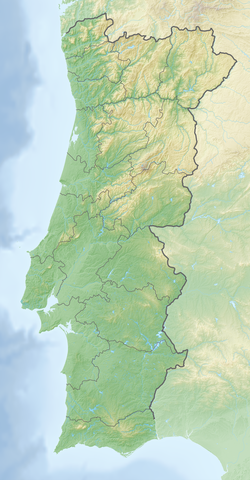Algarve | |
|---|---|
|
Top left to bottom right: aerial view of the capital of Algarve Faro; Estói Palace; City gates in Faro; A beach in Albufeira; The open fields of the Algarve in spring; Mourish style market of Loulé; Castle of Loule; The city of Portimão; Algarve's typical coast (Marinha Beach, near Lagoa) | |
 The Algarve Region in Portugal | |
| Coordinates: 37°14′31″N 8°10′12″W / 37.242°N 8.170°W | |
| Country | |
| Kingdom of Algarve within the Kingdom of Portugal | 1249–1815 |
| Constituent kingdom of the United Kingdom of Portugal, Brazil and the Algarves | 1815–1825 |
| Region of the Portuguese Republic | since 1910 |
| Capital | Faro |
| Area | |
| • Total | 4,996.80 km2 (1,929.28 sq mi) |
| Population (2021) | |
| • Total | |
| • Rank | |
| Demonym(s) | Algarvio algarvio (m.), algarvia (f.) |
| GDP | |
| • Rank total | |
| • Rank per capita | |
| • Total | |
| • Per capita | |
| Time zone | UTC+0 (WET) |
| • Summer (DST) | UTC+1 (WEST) |
| ISO 3166 code | PT-08 |
| HDI (2021) | very high · 4th |
| Website | visitalgarve |
| Statistics from INE (2005); geographic detail from Instituto Geográfico Português (2010) | |
The Algarve (UK: /ælˈɡɑːrv, ˈælɡ-/, US: /ɑːlˈɡɑːrvə, ælˈ-/;[4][5][6][7][8][9] Portuguese: [alˈɣaɾvɨ] ) is the southernmost NUTS II region of continental Portugal. It has an area of 4,997 km2 (1,929 sq mi)[10] with 467,495[11] permanent inhabitants and incorporates 16 municipalities (concelhos or municípios in Portuguese).[12]
The region has its administrative centre in the city of Faro, where both the region's international airport and public university, the University of Algarve, are located. The region is the same as the area included in the Faro District and is subdivided into two zones, one to the West (Barlavento) and another to the East (Sotavento). Tourism and related activities are extensive and make up the bulk of the Algarve's summer economy. Production of food which includes fish and other seafood, as well as different types of fruit[13] and vegetables such as oranges, figs, plums, carob pods, almonds, avocados, tomatoes, cauliflowers, strawberries, and raspberries, are also economically important in the region.
Although Lisbon surpasses the Algarve in terms of tourism revenue,[14] the Algarve is still, overall, considered to be the biggest and most important Portuguese tourist region, having received an estimated total of 4.2 million tourists in 2017.[15] Its population triples in the peak holiday season due to seasonal residents.[16] Due to the high standards of quality of life, mainly regarding safety and access to public health services, as well as due to cultural factors and considerably good weather conditions, the Algarve is becoming increasingly sought after, mostly by central and northern Europeans, as a permanent place to settle.[17] Several studies and reports have concluded that the Algarve is among the world's best places to retire.[18][19]
The Algarve is the fourth[20] most developed Portuguese region–in 2019, it was placed fourth out of seven regions with a human development index (HDI) of 0.847 (Portugal's HDI average was 0.864 in 2019). With a GDP per capita at 85.2% of the European Union average, it has the second highest purchasing power in the country only behind the Lisbon Metropolitan Area.[21]
- ^ "Produto interno bruto (B.1*g) a preços correntes (Base 2016 - €) por Localização geográfica (NUTS - 2013); Anual". www.ine.pt. Retrieved 3 September 2023.
- ^ "Produto interno bruto (B.1*g) por habitante a preços correntes (Base 2016 - €) por Localização geográfica (NUTS - 2013); Anual". www.ine.pt. Retrieved 3 September 2023.
- ^ "Sub-national HDI – Area Database – Global Data Lab". hdi.globaldatalab.org. Retrieved 31 July 2023.
- ^ Wells, John C. (2008). Longman Pronunciation Dictionary (3rd ed.). Longman. ISBN 978-1-4058-8118-0.
- ^ Jones, Daniel (2011). Roach, Peter; Setter, Jane; Esling, John (eds.). Cambridge English Pronouncing Dictionary (18th ed.). Cambridge University Press. ISBN 978-0-521-15255-6.
- ^ "Algarve". The American Heritage Dictionary of the English Language (5th ed.). HarperCollins. Retrieved 13 April 2019.
- ^ "Algarve". Collins English Dictionary. HarperCollins. Retrieved 13 April 2019.
- ^ "Algarve". Lexico UK English Dictionary. Oxford University Press. Archived from the original on 22 March 2020.
- ^ "Algarve". Merriam-Webster.com Dictionary. Merriam-Webster. Retrieved 13 April 2019.
- ^ "Áreas das freguesias, concelhos, distritos e país". Archived from the original on 5 November 2018. Retrieved 5 November 2018.
- ^ "Statistics Portugal". ine.pt. Archived from the original on 28 July 2021.
- ^ Cite error: The named reference
law75was invoked but never defined (see the help page). - ^ "JBI GROUP -". JBI GROUP (in Portuguese). Retrieved 25 September 2022.
- ^ "Lisboa ultrapassa pela primeira vez 1.000 milhões de euros em receitas de alojamento turístico". No. Economy. O Jornal Económico. Archived from the original on 2 March 2018. Retrieved 26 February 2018.
- ^ "Algarve com 4,2 milhões de turistas e 20 milhões de dormidas oficiais em 2017 – AHETA". No. Economy. Diário de notícias. Retrieved 26 February 2018.
- ^ Gonçalo Correia; Diogo Lopes (28 July 2017). "O "outro Algarve" é um paraíso". Sábado. Retrieved 18 March 2020.
- ^ "Algarve ganha 5.545 "novos cidadãos" num ano". Jornal do Algarve. 10 July 2018. Retrieved 18 March 2020.
- ^ "Algarve once again elected best place in the world to retire". The Portugal News. 18 August 2016. Retrieved 22 November 2018.
- ^ "How to retire in Portugal: your top questions answered". Expatica Portugal. Retrieved 25 November 2022.
- ^ "Sub-national HDI – Area Database – Global Data Lab". hdi.globaldatalab.org. Retrieved 12 December 2021.
- ^ "Internal Market, Industry, Entrepreneurship and SMEs – Algarve Region of Portugal". European Commission. Retrieved 19 March 2020.










